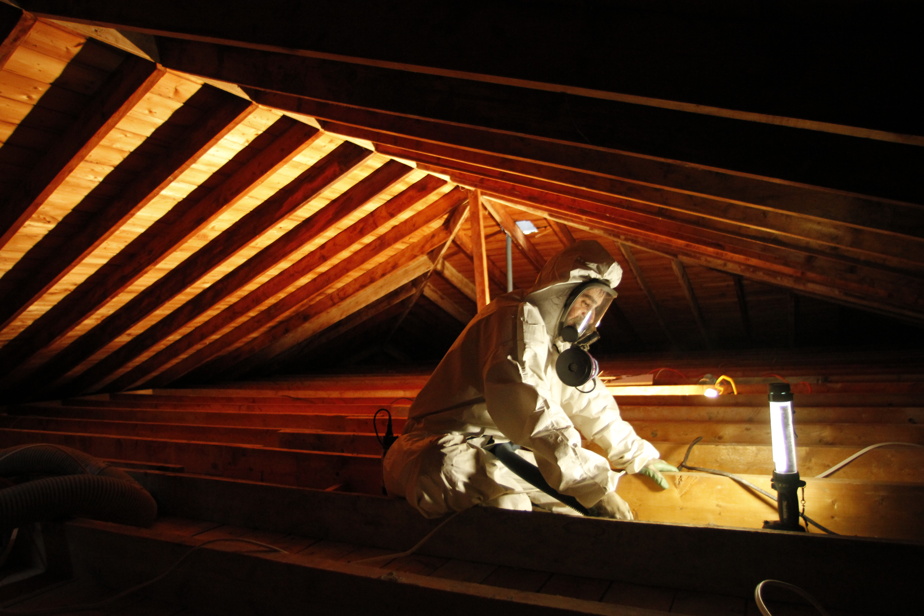Testimony: Katherine and Pascal, from Laval
Professional: Cédric Simoneau, director of operations, Multiservices FMB
Start of work: January 2024
Estimated end of work: March 2024
The beginning

PHOTO MARTIN TREMBLAY, THE PRESS
Katherine and her partner Pascal
The presence of a contaminant in a home is never desirable. Asbestos, vermiculite or even mold are all sources of health hazards. For asbestos and vermiculite, decontamination work involves several stages. The first is to check if there is really a contaminant present and what the percentage is. To help us better understand the whole process, we follow the story of Katherine and Pascal.
Why did you choose this house?
Katherine: Our family was growing, this house allowed us to be owners while remaining near Montreal and corresponded to our budget.
When you bought the house, did you know that a contaminant was present?
Katherine: Yes. The sellers told us it was vermiculite, which had not been tested. Vermiculite often contains asbestos, so we knew it was a possibility, but we weren’t sure.
Contaminants

PHOTO MARTIN TREMBLAY, THE PRESS
Cédric Simoneau (left), operations director, and Maxime Brûlé, owner of Multiservices FMB
What are the main types of contaminants?
Cédric Simoneau: Asbestos is the main contaminant that can be found in vermiculite. This is what is dangerous for health. Asbestos can also be found in other types of materials.
Where is asbestos hiding?
- In vermiculite (often in the attic and in walls), a popular insulation before 1980
- In stucco, plaster (often walls or ceilings)
- In tiles (often glued tiles, often found behind fireplaces in homes)
- In plumbing pipe insulation (often in schools and commercial buildings)
The evaluation

PHOTO ARCHIVES THE PRESS
This is what vermiculite looks like (under the insulation) where asbestos may be hiding.
What was the first step?
Katherine: Contact a reputable company to come take samples and analyze them according to the contractor’s recommendations (sample sites in walls, ceilings and vermiculite).
How did you react when you were told that a contaminant was present?
Katherine: We were relieved to learn that it was only in vermiculite, and in limited quantities (less than 1%). However, we were also worried about the additional costs that this would generate for our renovation work.
When you receive a report of the presence of a contaminant, how do you handle what happens next?
Cédric Simoneau: First, one of our agents will contact the client to review the problem and request the analysis report. We will then be able to provide the client with a quote explaining the process for safely removing asbestos.
Decontamination

PHOTO PROVIDED BY MULTISERVICES FMB
Decontamination process in progress
Is this process expensive?
Cédric Simoneau: Asbestos work can be expensive and scare clients. However, as I often like to say, every problem has its solution.
Decontaminate, step by step

PHOTO PROVIDED BY MULTISERVICES FMB
Asbestos removal work in progress
- Preparing containment zones: it is important to create work zones under negative pressure in order to protect the rest of the house from contaminating it.
- Carry out asbestos removal work, apply an encapsulating sealant for spores and dispose of the waste.
- Following asbestos removal work, it is always essential to carry out an air test in the work area to ensure that there are no more spores remaining in the air.
- Undo the containment zone.
- Reinsulation (in an attic) or reconstruction, if it concerns walls or ceilings.
The following

PHOTO PROVIDED BY MULTISERVICES FMB
Depending on the year the house was built or the signs of the presence of contaminants, think about your safety before undertaking demolition work yourself.
Knowing that if we do not release the contaminant, it is possible to coexist with it, would you do the same thing despite all the costs?
Katherine: Yes, absolutely. We made the choice to test only before major work. We lived there for five years before getting tested. Doing renovations makes checking vermiculite essential to ensure the health and safety of our families and workers.
Stéphanie’s advice
More and more new owners want to get their hands dirty with renovation work. Many will choose the demolition part to save money and let off some steam. That’s great, but the reality is that it can be dangerous. Depending on the year the house was built or the signs of the presence of contaminants, think about your safety. It is best to have a test carried out before undertaking the work.
